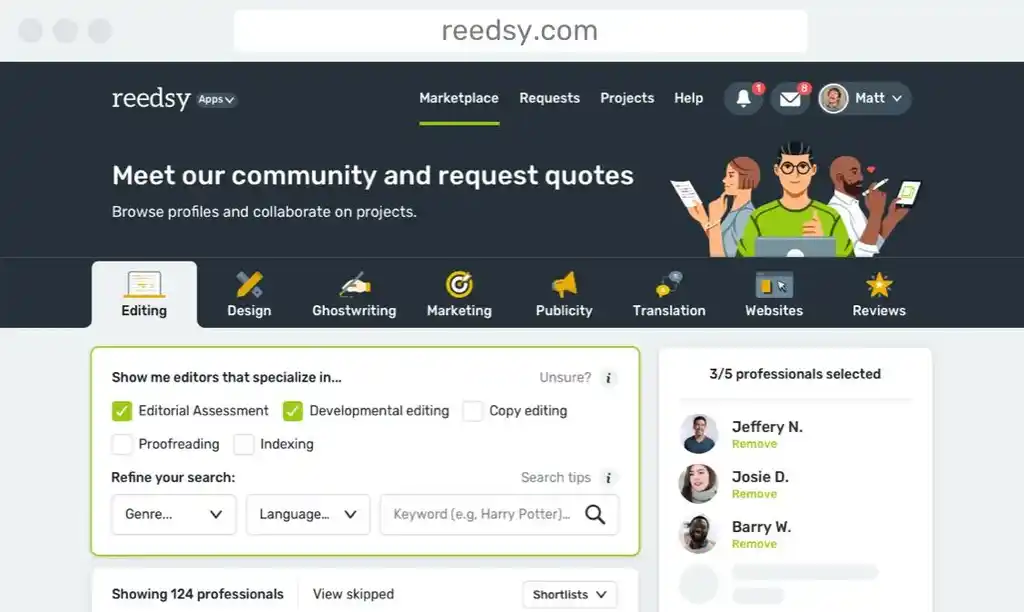Blog •
Posted on Jul 05, 2018
How to Get Freelance Clients: 7 Insider Tips to Help You Succeed
Ricardo Fayet
Reedsy co-founder and Chief Marketing Officer, Ricardo Fayet has worked with hundreds of authors on their launches and marketing campaigns. He is the author of two bestselling guides on marketing for authors, and a regular presenter at the largest writers' conferences.
View profile →Since we started Reedsy a few years ago, we have seen hundreds of our freelance professionals get thousands of projects through our marketplace. Some used good tactics, some not so much, so we decided to share insider tips on how the most successful freelancers get clients.
To sum it up, you need to do this to get more freelance clients:
- Show the value you will bring to the table
- Engage with your client
- Ensure that your quotes are clear
- Use templates to cover all of the basics
- Keep your online profile specialized and showcase your expertise
- Don't underestimate your client's budget
- Think twice before declining a project
Now let's dive into it!
1. Show the value you will bring to the table
You might think that in a situation where authors are sampling a number of quotes, the cheapest one always wins. But this isn't necessarily true. Though it's undeniable that some authors are hunting for the lowest price, only 50% of Reedsy clients statistically accept the cheapest offer! Many others take the quality of work, communication and general engagement of the freelancer into consideration, resulting in collaborations built on mid- to high-range feeds.
What does this show? Well, it tells you that your prices don't have to be the cheapest as long as you can show your value that you bring to the project. If you're prepared to do that, it's much more likely that you will make your prices work, even if they're not the cheapest.
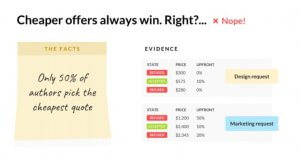 Real Reedsy requests examples
Real Reedsy requests examples
Just take this example above, which comes straight from our marketplace and shows projects where offers almost twice as high as the lowest offer are being accepted. This isn't to say that you should just charge crazy prices, of course — but making your high-end pricing work shouldn't be a concern on Reedsy.
PRO-TIP: Check out our post on how much editors and designers make to see how your prices compare to the rest of the market.
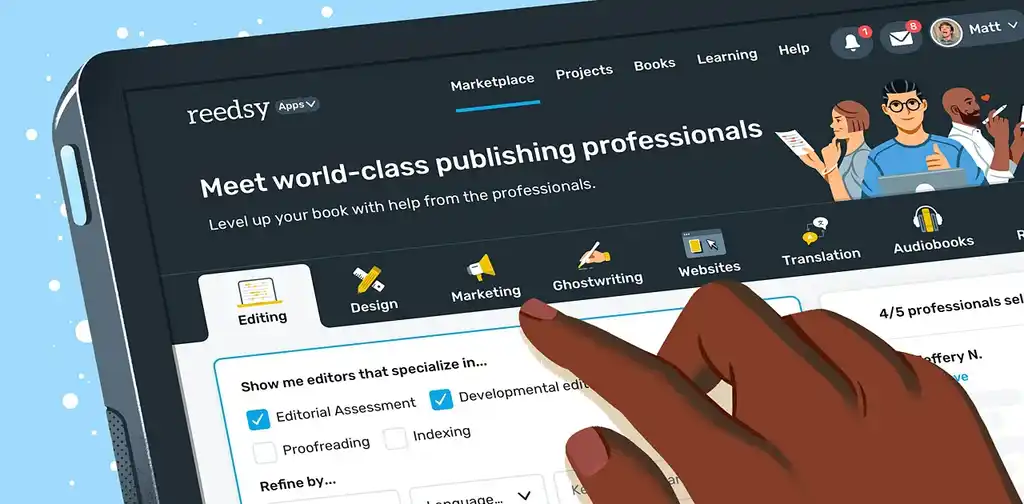
FIND CLIENTS
Grow your business on Reedsy
Submit your application to join our curated network and connect with clients.
Q: How do you optimize your profile to get the right clients for you?
Suggested answer
My profile is designed to be clear and transparent, offering as much information upfront as possible. To achieve this, I've organised it into the following sections:
Introduction
Here, I share my background and expertise as a designer, highlighting my ability to meet diverse client needs while consistently delivering exceptional creativity and professionalism.
Services
In this section, I detail the services I provide, emphasising my expertise in delivering high-quality design solutions across various mediums. I also highlight my technical support for authors at any stage of their publishing journey, along with my dedication to minimalistic design and meticulous attention to detail.
How I work
In this section, I describe my design approach, which consists of three phases: Analysis, Ideation & Creation, and Delivery.
Frequently asked Questions
Lastly, I address some common questions about my design process, providing clarity and setting expectations for clients. These include project turnaround time, questions about rights ownership and the use of generative AI.
Jonathan is available to hire on Reedsy ⏺
For me, optimizing my Reedsy profile wasn’t about trying to appeal to everyone. It was about being honest about what I do best. I focused on the genres I love working with, shared a few covers I’m truly proud of, and wrote a short intro that sounds like me. That way, the authors who reach out usually “get” my style, and we’re on the same page from the start.
Evgeniia is available to hire on Reedsy ⏺
2. Engage with your client
Here's the thing: clients generally spend a lot of time researching freelancers to contact — meaning you are one of their top choices and they want to see you engaged with their project. So don't shy away from interaction! Ask yourself:
- “Is this an exciting project?”
- “Have I worked on something similar?”
- “How can I respond with a personal touch?”
Communicate clearly and prove your knowledge. If you're a book marketer, for instance, be prepared to know your lingo and talk about ROIs and KPIs. It'll help you to relate to the author’s project and elevate yourself to being a client’s number one choice.
3. Keep your quotes clear and concise
The offer not only helps form the details of your contract, but also confirms that clients understand what they are (and are not) getting. So when you're composing the offer, spend some time considering the details that are crucial for the client to understand. Consider including detailed information about the service you will be providing, how many iterations there will be and whether you would like to offer the client an opportunity to discuss your work (and for how long!) post factum.
Q: What do you include in your offers to clients?
Suggested answer
Although I do several kinds of editing, my offers always include these things:
- What kind of editing I'll be doing (I always talk to clients about what a manuscript needs before sending an offer and sometimes offer something different from what's listed in the brief if the author agrees)
- A description of what kinds of problems this editing is meant to resolve
- A hard number of either how many edits I'll do, whether partial reviews are acceptable, and how many returnables a client can expect
- My filetype preferences (usually Word)
- Any relevant style guide information
- How I'll be sending my final files (I upload them to Reedsy, of course)
- How clients can get in contact with me (through Reedsy, of course)
- What kinds of questions are appropriate to ask, given the scope of editing (when I'm copyediting, I don't field questions about how to find an agent, for example)
I follow up any offer with a message containing brief description of how Reedsy's fee structure works, how to navigate the website, what I'll need from a client before I can start a project, how a client can upload their relevant files, and what to expect in the time leading up to the start date. Often, I also mention how frequently a client can expect communication from me.
I have a document on my computer where I save (and occasionally edit) my contract boilerplate so I can copy/paste it quickly, just adding relevant changes to customize for each client. This ensures my offers are always well thought out but there's room to reassure clients that I'm taking their book's unique needs into account.
Sirah is available to hire on Reedsy ⏺
Illustrating a picture book isn’t just about making pretty pictures—it’s about crafting a whole visual experience that enhances the story. That’s why, when I take on a project, I offer a full-service approach. From the first rough sketch to the final print-ready PDF, I guide the book through its visual journey, making sure everything—from character design to typography—fits seamlessly together.
A Holistic Picture Book Service
When I work on a picture book, I don’t just illustrate; I design the book as a whole. My offer includes:
- Illustrations – Thoughtfully planned to match the pacing of the story.
- Cover Design – Creating a striking first impression that captures the essence of the book.
- Interior Layout – Ensuring the flow of text and images keeps the reader engaged.
- Book Formatting – Preparing a professional, print-ready PDF that meets publishing standards.
- Colour Scheme Development – Setting the right mood and tone throughout the book.
- Font Selection & Placement – Choosing and arranging text to complement the illustrations.
Transparency in Process & Collaboration
I know that authors have a vision for their stories, and I make sure they stay part of the creative process. Here’s how I keep everything transparent:
- Workflow Overview – I provide a clear step-by-step breakdown of the process so clients know what to expect at each stage.
- Miro Board Collaboration – I use Miro to share progress in real time. Authors can see sketches, leave comments, and even add reference images if they have specific ideas.
- Regular Updates – I keep communication open, making sure my clients always know where we are in the process.
Project Timeline & Availability
I don’t just say “yes” to a project and disappear into an art cave. I let my clients know upfront when I can start and how long it will take. Clear scheduling means no guessing games—just a structured, efficient process.
Budget & Payment Plan
Every project is unique, and so is its budget. I provide a detailed pricing breakdown so clients know exactly what they’re paying for. I also offer a structured payment plan, making it easier to manage costs while keeping everything on track.
At the end of the day, my goal is to bring stories to life in a way that feels seamless, exciting, and stress-free for the author. A picture book is more than just words and images—it’s an experience. And I make sure every element comes together to create something truly special.
Evgenia is available to hire on Reedsy ⏺
I always want my potential clients to have a very clear understanding of what to expect from me in our working relationship. So much about publishing and editing is opaque, so I'm always happy to answer questions and provide more detail on the areas that may not have a clearer path. But first and foremost, I want my clients to know that I won't miss a deadline, and clearly articulate what I'll be doing in my edits and what they will get in return.
By establishing a clear path through here on the Reedsy platform, it also creates a safety net for both myself as a freelancer and my clients. We both then have reference back to what was agreed, in writing, to avoid any confusion later on.
Matt is available to hire on Reedsy ⏺
When I send an offer, I try to keep it clear and reassuring. I always mention what’s included — full cover design (front, back, spine) for both ebook and print. I let authors know that revisions are unlimited, and payment only happens once they’re completely happy with the result. I also include the turnaround time and pricing upfront, so there are no surprises. And I always invite questions — good communication makes everything smoother.
Evgeniia is available to hire on Reedsy ⏺
If I am making an offer to a client it's because I am genuinely interested in their project. Therefore I try to show that by talking about the things in their project that I like, relate to and that inspire me. I will try to lift examples from previous work and/or experiences that I think are relevant and communicate a sense of enthusiasm.
Then I will outline how our collaboration could work by breaking up the project into smaller stages that lead to the final delivery. This is especially useful for first time clients who don't know how the collaborative process works and what I expect from them as well as what they can expect from me.
I also want to be very clear what the scope of my offer is, what is included and what is not. Therefore I will specifically state what the deliverables are going to be and write if there are things that I haven't included. For example an author might want illustrations for their book but haven't mentioned a design for the book cover. Therefore I will include the illustration work in the scope of my offer but the cover design will be outside the scope. I can then specify this as something extra if the client is interested. This way I can be sure we both understand each other before the project starts and we can hopefully avoid any confusion or disappointment. Reedsy lets you amend offers so I always point this out to clients and suggest they get in touch if they want to discuss or change anything in an offer such as the scope or time frame or even the budget.
Finally, as I like to have licensing control over the illustrations I make, I include an extra contract for the client which ensures my illustrations are used as intended. This is a standard contract for illustration work which grants the client limited use according to the scope of the project and helps protect me and the client from improper use of my work.
Ben is available to hire on Reedsy ⏺
I like to keep everything as transparent as possible.
In my cover design work, I always propose a very clear and simple menu. It’s literally like going to a restaurant—except this one only serves the best of what’s in season, and no hidden added costs!
What do I mean by that?
I always provide three to four different cover directions for your work. That’s just the initial concept phase. From there, I offer three rounds of changes to refine the chosen direction until we arrive at the final cover.
Once that’s done, I produce all the materials you need, tailored to your required specs, and I’m happy to make any necessary adjustments to ensure the final result is exactly right.
All of this is clearly listed in my menu so that an author knows exactly what they’re going to get, what they can ask for, and what I’m very happy to deliver.
At the end of the day, every project begins with an open question: What will make this book stand out?
And just as importantly: What will make this cover feel like a true representation of the author and their work?
That’s the spirit behind my offer. I’m always happy to show people how I structure it. It’s simple, but also thoughtfully detailed.
Lisa is available to hire on Reedsy ⏺
When I provide an offer to a client, I try to make sure that everything is as transparent and upfront as possible.
First, I will briefly comment on the brief that the client sent to me, and tell them the relevant experience I have in that area.
Next, I will explain the offer fee to the client, and I will direct them to Reedsy's "Cost of Publishing" blog page so that they can see how my pricing was calculated, and confirm that my pricing is in line with recommended Reedsy fees.
Following that, I will detail all of the services my work will entail and the approach that I will take. I make clear that I have a degree of flexibility in terms of workflow and that we can work to the author's preference. E.g. Submit chapters to me one at a time, or submit the whole thing.
I also explain to the client what my work does not entail, to avoid any potential misunderstandings. For example, if the client has asked for a development edit, then I will explain that my services will not include rigorous copy editing, or the creation of original content for them (i.e. ghost writing).
Lastly, I will strongly suggest that the client ensures that they are familiar with the publishing process before they hire the services of an editor, to make sure that they know what they're getting into, and what the big picture is going to be from writing that first chapter, up to getting their book out to the masses. Publishing is no small investment, either in time or money. The last thing I want is for a client to invest in development editing, only to be shocked that there is still a way to go before their book is ready to present to readers. Making sure that you understand the essentials of publishing from the outset is, well, essential!
Ian is available to hire on Reedsy ⏺
Every great manuscript carries a story behind the story—your lived experience, your creative spark, your goals for publication. My editorial partnership is designed to honor that depth while giving you concrete results, starting before a single invoice is sent.
First, you’ll receive a complimentary edit of up to 1,000 words. I dive into structure, tone, clarity, and market positioning, leaving margin notes that show both strengths and opportunities. This sample gives you a transparent preview of my approach and delivers instant value you can apply whether we move forward together or not.
Next, we’ll hop on a focused, twenty‑minute Zoom call; this can be reserved for before editing, or after as a post-mortem. Think of it as a mini strategy session: we’ll unpack the sample edits (or final edits), discuss your vision for the book, and outline potential pathways—from traditional submissions to hybrid or self‑publishing timelines.
To keep momentum (and avoid information overload) I follow up with a short sequence of emails. You’ll get a written recap of our conversation, tailored resources, and answers to any lingering questions about craft, process, or production costs.
Before I touch another word of your manuscript, you’ll complete a concise questionnaire covering target audience, comparable titles, desired release window, marketing comfort level, and any non‑negotiable stylistic preferences. These insights let me shape an edit that aligns with your brand, voice, and business goals—no cookie‑cutter track changes here.
Throughout, my priority is understanding the person behind the pages. By combining attentive listening with practical, industry‑savvy feedback, I aim to turn a daunting revision cycle into a guided, confidence‑building collaboration.
You’ll also have ongoing access for questions as edits progress, ensuring clarification in real time, not weeks later. Together, we’ll transform your draft into the polished, purpose‑driven book you envisioned—and feel proud to share.
Lauren is available to hire on Reedsy ⏺
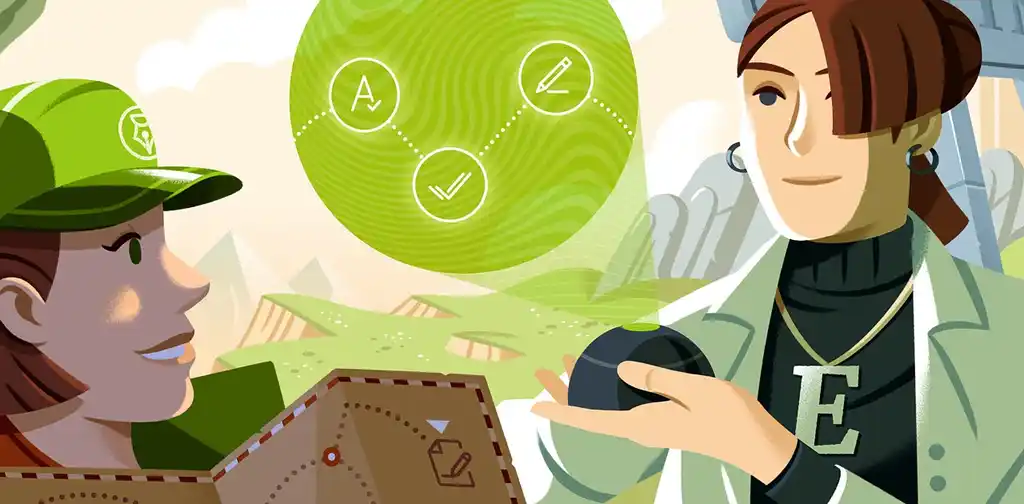
FREE RESOURCE
Offer Letter Checklist + Template
Follow our tips to successfully sell clients on your services while setting clear expectations.
4. Make templates your best friend
Templates (or pre-composed messages that you edit) will help you efficiently cover the basics every time. Another bonus: it will save you time that you could spend engaging with the important part of the work — the project itself. Ensuring every client gets all the information they need will avoid lots of questions later and instill confidence, as they then know what to expect from the start.
Q: Do you use any templates to streamline your proposal process?
Suggested answer
Over time I have developed a proposal template that shares a warm introduction, asks all the questions I need to get an initial handle on their project, and offers a price list for them to get an idea of what they may expect me to charge in my offer. The template is a few short paragraphs and a few bulleted lists. Lists work great for organizing information.
Chad is available to hire on Reedsy ⏺
When I first joined Reedsy, I struggled a little with my offers - like anything, practice is required! It was taking me ages to write them, and most were not accepted. I then tried a template, and sent those out with minor tweaks for each client request. Still no dice to speak of - just a couple of jobs over a few months (for which I was very grateful).
But, on the verge of giving up Reedsy, I decided to go back to individual offers, with no templates. I accepted it would take time, and it does. I can easily spend an hour, sometimes more, on each offer I make. I also aim to keep my offers simple, straight-forward, and easy to understand. I now get a regular stream of work via Reedsy, and I think my individualised offers have contributed to this. Of course, I do end up writing the same sort of stuff in many of my offers - a developmental edit is a developmental edit, no matter what - but I also tailor my proposed work to each manuscript. I also pay very close attention to the request, and try to get to the heart of what the writer is truly after. This is really important. I also ask questions in my offers, and invite the client to ask questions of me too.
So far, so good!
Louise is available to hire on Reedsy ⏺
Templates also work as checklists, making sure you have all of the necessary information to provide an accurate and detailed quote. It’s all good when clients talk about how much they love or hate the book they have written, but sometimes they miss the more trivial, nitty-gritty details about their project and what they service they actually need!
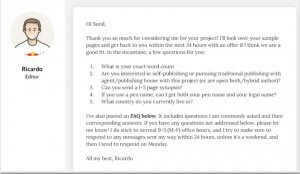
A template used by one of Reedsy freelancers
Pro-tip: Download a freelance quote template for free right here!
5. Don’t be a Jack, or Jill, of all trades
Most importantly, make sure your online profile is specialized. If a client is looking for a romance editor, for instance, they're looking for a romance editor. Saying that you specialize in editing all kinds of fiction and non-fiction books — while offering every single editing service under the sun — isn't going to appeal to that client.
That's why you want to rule your niche. If you narrow down your specialty areas, it will help funnel more considered requests your way — moreover, the projects will actually be of interest to you. Showing your expertise in a particular field will also give more confidence to the clients that you will make their book the best it can be.
You can see some of our top tips on creating a great professional profile here.
6. Don’t underestimate your client’s budgets
It might also cross your mind that publishing houses pay much more than standalone authors. Well, that's simply not true: although publishers do invest in the production process, they're still companies trying to make their business efficient. In the past few years, most of them downsized significantly, and their budgets for freelancers shrank. Self-publishing authors, on the other hand, want the best for their book (their baby!). If they find the perfect professional, they will consider paying more, especially if you show them the value you can bring.

FREE RESOURCE
Invoice Template
Provide billing and payment details with this professional template.
7. Think twice before declining
We all know it’s easier to work on something that you are interested in, so give yourself the opportunity to find that out before you decline a project. Don't decline unless you’re actually too busy for the next few months, or really can't help with any of the services the client is asking for.
Other details can be worked out, whether it's the timeline that doesn’t fit you (always ask if the client is flexible), or if you feel that they need help with more aspects than you can cover. Just let them know and discuss what you can do for them. With some projects, you'll be able to reach an agreement — which will get you that much closer to getting freelance clients.
Not a Reedsy professional yet? We’re always looking for more talented freelancers! Go ahead and join our community here to start getting freelance clients and getting paid.

FREE RESOURCE
The Full-Time Freelancer's Checklist
Get our guide to financial and logistical planning. Then, claim your independence.
